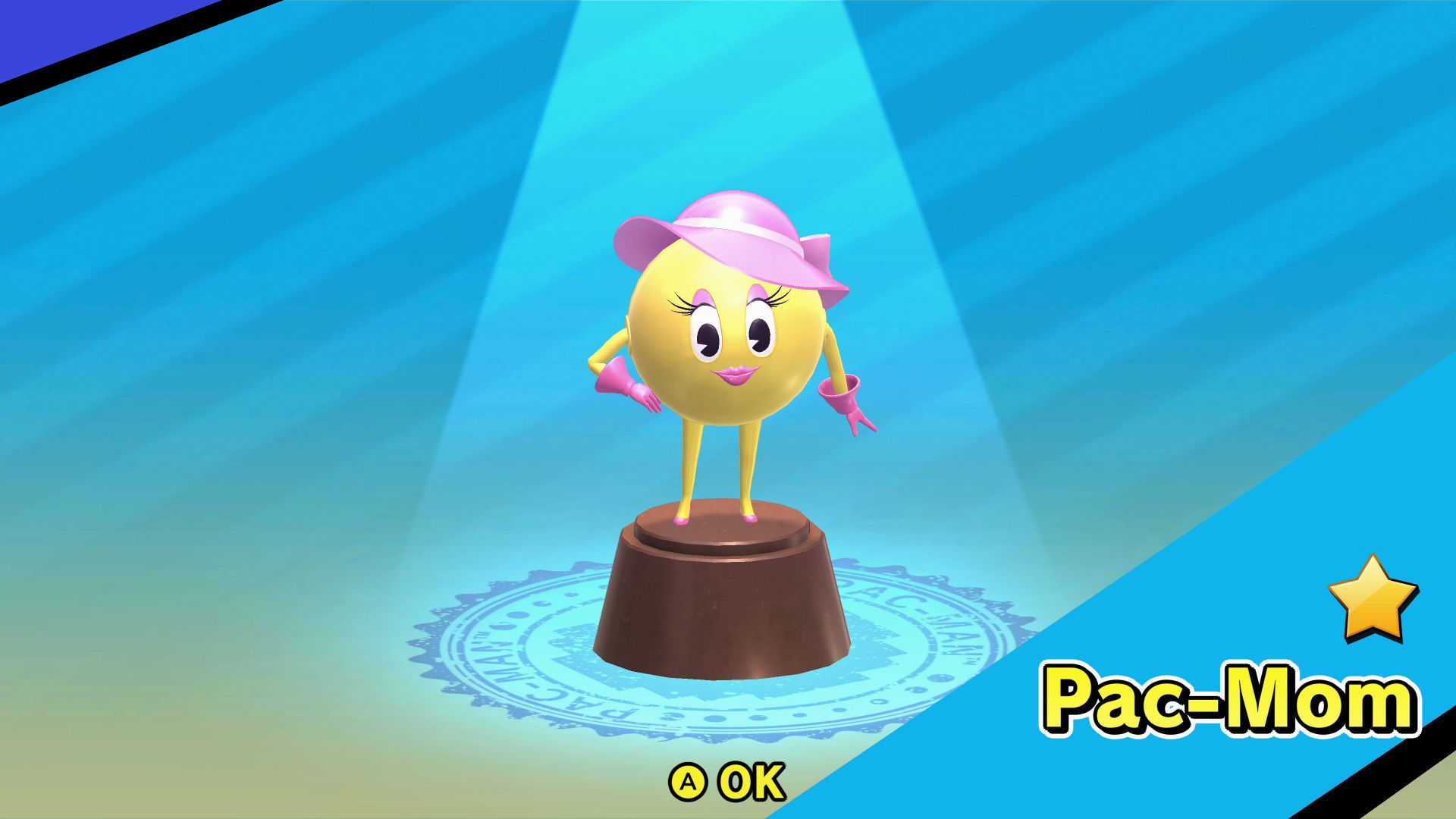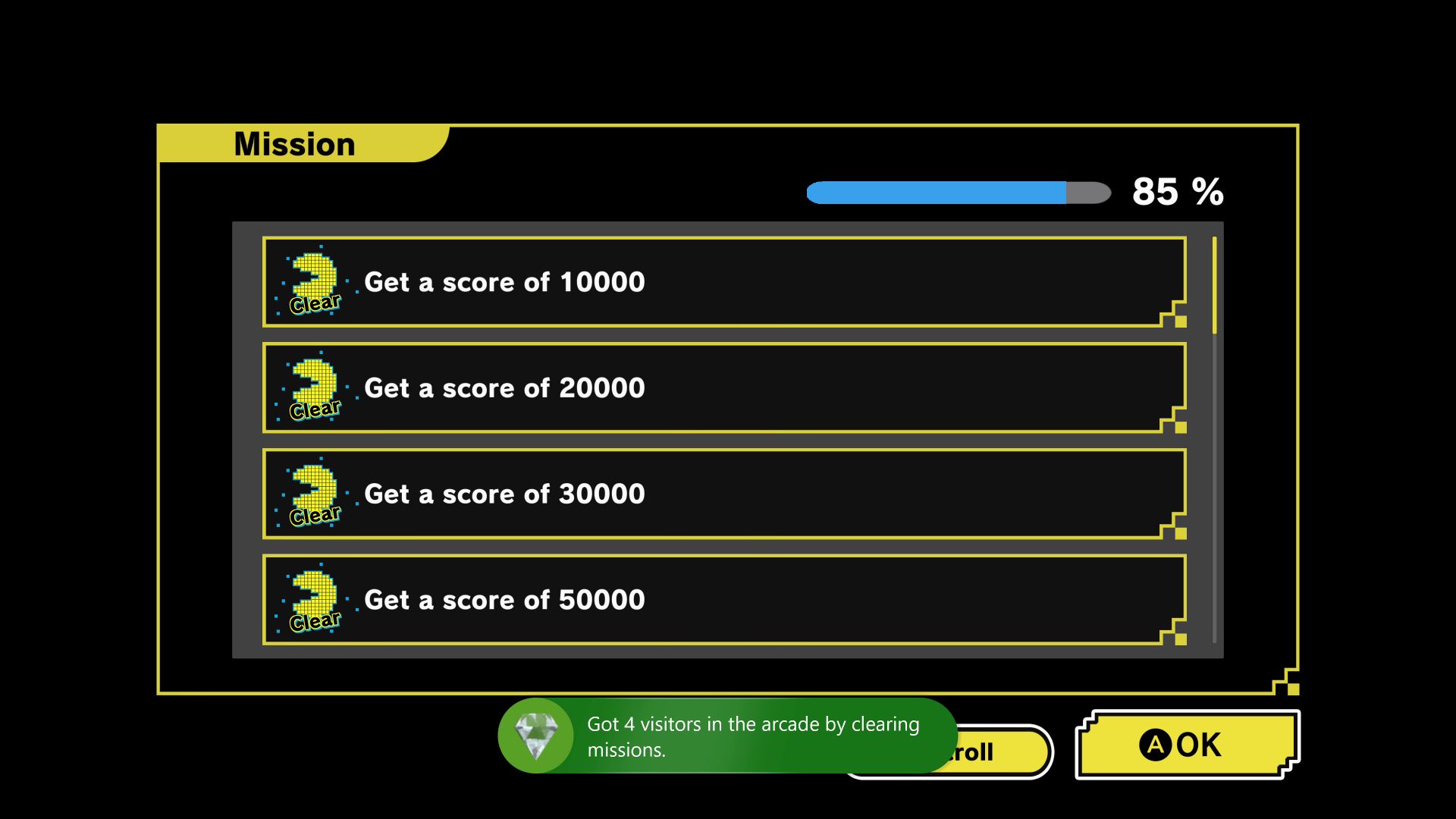

Over 40 years after his creation, Pac-Man remains a popular character among both gamers and mainstream audiences. The Pac’s legacy lives on in the gaming world thanks to intermittent sequels, remasters (like Pac-Man World Re-Pac), and collections. Pac-Man Museum Plus is the latest collection of Pac-Man games, a sequel to 2014’s Pac-Man Museum. The new collection boasts 14 games from Pac-Man’s history, including two co-op titles: Pac-Man Arrangement and Pac-Man 256. Throw in numerous missions for each game, a customizable arcade, a virtual Gashapon machine, and you get one super collection that Pac-fans will love.
Pac-Man Museum Plus (the real title has a plus symbol) starts players in a virtual arcade populated by a handful of arcade cabinets, only a few of which are initially available for play. Additional games can be unlocked by playing certain games twice, which doesn’t take long at all. The 7 actual arcade games show up as cabinets, whereas the 7 non-arcade titles can be played via the “free” cabinet. All 14 games can also be played from a list by pressing the Start/Menu button.

Pac-Mom is Bandai Namco's weird replacement for Ms. Pac-Man.
The overall goal in Museum Plus involves collecting and spending coins. Gamers start with a certain number of coins which can be spent on playing arcade cabinets, purchasing decoration items from the vending machine, or in the Gashapon machine. The coin mechanic might sound worrisome, but only the seven genuine arcade games cost coins to play. Players will earn coins back just by playing (and extra coins from doing well), so completely running out shouldn’t be an issue.
Decorations and Gashapon figures are fun to collect, but the actual decorating element is limited by the size of the virtual arcade. At 16 x 10 spaces, the arcade itself is a bit small for my liking. The walls can be customized with a huge variety of unlockable wallpapers, though, including some that reference the Atari 2600 Pac-Man and even Pac-Man cereal! The arcade also contains a jukebox with plenty of unlockable music from most of the games in this collection as well as the Pac-Man 40th Anniversary Album. All told, the virtual arcade here offers a decent number of things to see, hear, and do, and is a significant improvement over the original Pac-Man Museum’s dinky trophy room.

The 14 games in Museum Plus all have 12-20 optional missions to complete, such as reaching specific stages, earning high scores, or eating certain numbers of ghosts. These goals add a lot of fun and replay value to each game. Some of the missions are brutally difficult, but many of the games allow players to restart the current stage via a temporary save. Without this feature, it would be virtually impossible to complete all missions. As it stands, plan to spend 1-2 hours with each game in order to complete its missions.
Returning games
All nine of the base games from the original Pac-Man Museum are included in Museum Plus. Ms. Pac-Man, which was sold as DLC for Museum, is not offered here, sadly. These games are single-player, with two also offering competitive modes:
Pac-Man (1980)
Pac-Man (1980): The original arcade game is still fun, especially if you learn a solid pattern. Super Pac-Man (1982): The first Japanese-developed sequel adds locked doors with keys and the ability to temporarily turn super. Pac & Pal (1983): Building off the maze designs of Super Pac-Man, this strange game gives Pac-Man an AI-controlled partner and the ability to stun ghosts with power-ups. Pac-Land (1984): The first Pac-Man platformer is a bit slow and basic but gets better once you learn the tricks. Just like in Pac-Man Museum, Bandai Namco neglects to tell players how to use the springboards, a necessary mechanic. Here’s how: rapidly tap in the direction you want to hover after using the springboard. Also noteworthy, this version of Pac-Land replaces Ms. Pac-Man and Jr. Pac-Man with new, knockoff-ish designs, presumably to avoid licensing the original characters from AtGames. Pac-Mania (1987): This sequel plays a lot like the original game but with an isometric viewpoint and the ability to jump. It’s super hard because of the highly zoomed-in viewpoint. Pac-Attack (1993): A falling-block puzzle game that features single-player and versus multiplayer modes. The previous Museum featured the Genesis version of Pac-Attack, but Museum Plus includes the Super Nintendo version. Pac-Man Arrangement CS Ver. (2005): Confusingly, there are two different games called Pac-Man Arrangement: the 1996 arcade game and 2005 PSP game. The PSP game originally supported 2 players, but all re-releases (including this one) are single-player. It’s a great game with exciting boss battles, and it would be even better if Bandai Namco restored co-op support! Pac-Man Championship Edition (2007): The first Pac-Man sequel developed by Pac-Man creator Toru Iwatani, Championship Edition adds multiple timed modes and plenty of visual style. Sadly, the even-better sequel, Championship Edition DX, is not included here. Pac-Man Battle Royale (2011): A competitive game based on Championship Edition with single-player and 4-player versus modes. This one is fun in small doses but awfully light on content and options. New Games (Non-Cooperative)Pac-in-Time
These non-cooperative games were not included in the original Pac-Man Museum:
Pac-in-Time (1995): A strange 2D platformer that was originally developed by a French studio. Museum Plus uses the Super Famicom version of the game but adds English subtitles. Given the unintuitive nature of the gameplay, players might need a guide to succeed. Pac-Motos (2007): Originally released on Wii, Pac-Motos is a competitive game in which 1-4 players try to knock all enemies off the stage. Pac-Motos is this collection's best game for farming coins. Pac 'n Roll Remix (2007): A stripped down version of Pac ‘n Roll for Nintendo DS, Remix has players rolling Pac-Man like a marble through a small set of stages while trying to avoid falling off or getting eaten by ghosts. New Games (Cooperative)Pac-Man Arrangement (1996)
These cooperative games were not included in the original Pac-Man Museum:
Pac-Man Arrangement (1996): In this arcade sequel, one or two local players try to clear each round by eating all dots while avoiding the ghosts. When playing in co-op, the second player controls a green Pac-Man. A fifth ghost, Kinky, combines with other ghosts, making them more dangerous. Several new power-ups provide effects such as super speed, temporarily trapping the ghosts, a mirrored Pac-Man that eats dots and can’t be hit, and more.
Arrangement consists of 23 rounds spread across five worlds. The difficulty is quite manageable thanks to the ability to continue upon reaching a game over. The colorful 2D graphics exude a 32-bit charm, and the music is pretty catchy too. Given the appealing art, co-op support, and reasonable game length and difficulty, Arrangement is a highlight of this collection.
Pac-Man 256
Pac-Man 256 (2016): Most Pac-fans probably already own Pac-Man 256, which sells for $5 on Xbox, PlayStation, and Steam. The Switch didn’t have a version of 256 before now, though. 256 also happens to be an excellent, highly replayable game, so the fresh chance to play it here is a treat.
Based on the gameplay of Crossy Road, Pac-Man 256 takes place in an endlessly scrolling maze. 1-4 local players try to earn all the points they can by eating dots and ghosts, collecting coins for upgrades, and avoiding not only ghosts but also the Glitch that relentlessly eats away at the bottom of the maze. The team unlocks a total of 21 power-ups by reaching new dots-eaten milestones. Power-ups can then be upgraded with coins, adding lots of replay value.
256 is a joyous cooperative experience. The game offers six selectable characters, so everyone doesn’t have to look the same. Even then, four characters zooming around the crowded stage while the Glitch chases after them is inherently frantic and chaotic. When a player dies, the surviving players can resurrect him or her by finding a power-up that appears after death. Racing to grab the respawn item while ghosts close in leads to some exciting “save the team” moments.
ConclusionPac-Man 256
Pac-Man Museum Plus isn’t a fully comprehensive collection. It’s sadly missing Ms. Pac-Man and several other Pac titles, some developed by Namco and some by others. Still, it does offer a wide variety of titles, several of which weren’t in the previous collection. The optional missions will give completionists and Achievement hunters numerous hours of enjoyment, but even casual fans will find plenty to love here. Compared to the similar Space Invaders Invincible Collection, which sells for $60 with 11 games included, Pac-Man Museum Plus is a steal. Grab it and catch some Pac-Man Fever!
Pac-Man Museum Plus sells for $19.99 (digitally) on Xbox/Windows Store, PlayStation, Switch, and Steam. The physical versions cost $19.99 for Xbox and PlayStation, and $29.99 on Switch. The Xbox/Windows Store versions are also available on Game Pass at the time of this writing.
An Xbox review code was provided by the publisher.